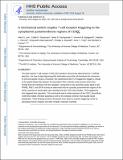| dc.contributor.author | Lee, Mark S. | |
| dc.contributor.author | Glassman, Caleb R. | |
| dc.contributor.author | Deshpande, Neha R. | |
| dc.contributor.author | Badgandi, Hemant B. | |
| dc.contributor.author | Parrish, Heather L. | |
| dc.contributor.author | Kuhns, Michael S. | |
| dc.contributor.author | Uttamapinant, Chayasith | |
| dc.contributor.author | Stawski, Philipp Sebastian | |
| dc.contributor.author | Ting, Alice Y | |
| dc.date.accessioned | 2017-06-26T18:56:27Z | |
| dc.date.available | 2017-06-26T18:56:27Z | |
| dc.date.issued | 2015-08 | |
| dc.identifier.issn | 1074-7613 | |
| dc.identifier.issn | 1097-4180 | |
| dc.identifier.uri | http://hdl.handle.net/1721.1/110270 | |
| dc.description.abstract | The eight-subunit T cell receptor (TCR)-CD3 complex is the primary determinant for T cell fate decisions. Yet how it relays ligand-specific information across the cell membrane for conversion to chemical signals remains unresolved. We hypothesized that TCR engagement triggers a change in the spatial relationship between the associated CD3ζζ subunits at the junction where they emerge from the membrane into the cytoplasm. Using three in situ proximity assays based on ID-PRIME, FRET, and EPOR activity, we determined that the cytosolic juxtamembrane regions of the CD3ζζ subunits are spread apart upon assembly into the TCR-CD3 complex. TCR engagement then triggered their apposition. This mechanical switch resides upstream of the CD3ζζ intracellular motifs that initiate chemical signaling, as well as the polybasic stretches that regulate signal potentiation. These findings provide a framework from which to examine triggering events for activating immune receptors and other complex molecular machines. | en_US |
| dc.description.sponsorship | National Institutes of Health (U.S.) (5R01CA186568) | en_US |
| dc.language.iso | en_US | |
| dc.publisher | Elsevier | en_US |
| dc.relation.isversionof | http://dx.doi.org/10.1016/j.immuni.2015.06.018 | en_US |
| dc.rights | Creative Commons Attribution-NonCommercial-NoDerivs License | en_US |
| dc.rights.uri | http://creativecommons.org/licenses/by-nc-nd/4.0/ | en_US |
| dc.source | PMC | en_US |
| dc.title | A Mechanical Switch Couples T Cell Receptor Triggering to the Cytoplasmic Juxtamembrane Regions of CD3ζζ | en_US |
| dc.type | Article | en_US |
| dc.identifier.citation | Lee, Mark?S. et al. “A Mechanical Switch Couples T Cell Receptor Triggering to the Cytoplasmic Juxtamembrane Regions of CD3??” Immunity 43.2 (2015): 227–239. | en_US |
| dc.contributor.department | Massachusetts Institute of Technology. Department of Chemistry | en_US |
| dc.contributor.mitauthor | Uttamapinant, Chayasith | |
| dc.contributor.mitauthor | Stawski, Philipp Sebastian | |
| dc.contributor.mitauthor | Ting, Alice Y | |
| dc.relation.journal | Immunity | en_US |
| dc.eprint.version | Author's final manuscript | en_US |
| dc.type.uri | http://purl.org/eprint/type/JournalArticle | en_US |
| eprint.status | http://purl.org/eprint/status/PeerReviewed | en_US |
| dspace.orderedauthors | Lee, Mark S.; Glassman, Caleb R.; Deshpande, Neha R.; Badgandi, Hemant B.; Parrish, Heather L.; Uttamapinant, Chayasith; Stawski, Philipp S.; Ting, Alice Y.; Kuhns, Michael S. | en_US |
| dspace.embargo.terms | N | en_US |
| dc.identifier.orcid | https://orcid.org/0000-0003-1729-9873 | |
| dc.identifier.orcid | https://orcid.org/0000-0002-8277-5226 | |
| mit.license | PUBLISHER_CC | en_US |
